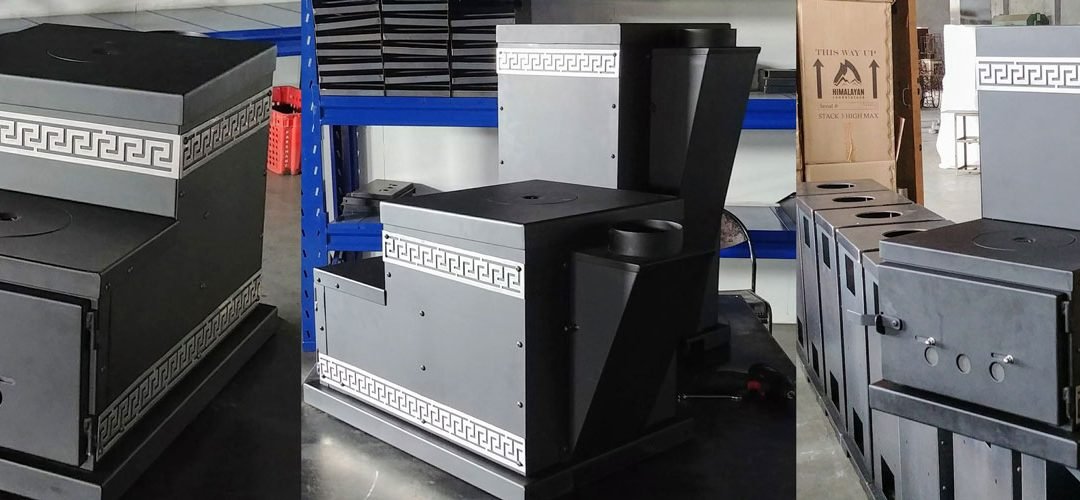What is the Himalayan Rocket Stove?
Clean efficient biomass combustion for Himalayan households (and beyond)
What’s in a name?
At Himalayan Rocket Stove, we use design that is known around the world as a “rocket stove”. There are both metallic and non-metallic versions of rocket stoves, in each case the design principles are the same. With metallic rocket stoves, the issues that arise are usually due to the improper use of mild or inappropriate steel. We use a high quality, high temperature rated stainless steel (SS310) which is showing no signs of wear in any of our units that have been used for more than a year. The SS310 riser tube is wrapped in ceramic wool to provide insulation to the vertical combustion chamber, which achieves the same effect as insulative refectory material, but which is easier to manufacture and transport.
There are various styles of rocket stove, from the simplest L-curve cookstoves that have sticks fed horizontally into the base of an insulated vertical tube (often used as improved cookstoves), to J-curve where the sticks are fed down into a primary combustion zone and wood smoke is drawn into the riser tube, and then there is what is loosely known as the “Batch Box” style where wood is fed into a closed primary box for combustion and the released wood gases are drawn into the vertical riser tube.
In all cases there is a riser tube of some sort. The cooking variants have an exposed riser, whereas heating stoves such as ours place the riser inside a metal container where the hot gases are trapped in order to increase heat transmission into the room before being vented via a low exit port to a flue gas pipe.
The Best Wood Burning Cook Stove range (we have 3 sizes) all use a 5” diameter riser (of differing lengths) and 5” exhaust pipe where possible, although 4” will work if the bends are minimal and the rise is enough to give considerable updraft. The primary burn chamber is approx 400mm wide, 300mm deep and 250mm high.
Our stoves have additional features over and above standard rocket stoves (if there is such a thing) in that we also incorporate pre-heated primary and secondary air to improve combustion effectiveness in a high temperature environment.
The Himalayan part of our name refers to the fact that we designed our heaters for the Himalayas, where most people in the mountains use their wood heater for cooking even if they have gas cooking at home. Cooking traditionally means sitting low to the ground, so the height had to be adjusted to suit this (in our Eco1 Rocket Stove).
As a social enterprise, Himalayan Rocket Stove is progressing as planned and indications for it to scale into a successful venture are looking very promising. We are focussed on achieving a triple bottom line (Social, Environmental and Financial returns) targeting the clean energy sector. Our target markets are initially in India and will scale to include the rest of the Himalayan regions and then other target markets globally where clean efficient biomass combustion is a need.
The not-for-profit company Smokeless Cookstove Foundation has emerged as a standout parallel offshoot of this work with the potential to save millions of lives over the coming years. The Smokeless Cookstove Foundation operates education and training programs designed to empower villagers to make their own smokeless rocket stoves with our designs that cost almost nothing to implement. We are very proud of the achievements being made in this area by the Foundation team, many of whom are also HRS team members.
For more information about either of these projects:


I am interested. But for next winter.
That’s fine, whenever suits you.
Can we burn pine needles in this
You can, but it might build up ash quickly if that is the only fuel you are using. It would work better with a mix of wood and pine needles for more consistent burning.
I take it that the max size of logs would be 30cm?
I think we are getting about 15″ logs diagonally quite easily (375mm)
how do you get the ashes out?
The main door opens and there is an ashtray that lifts out of the primary combustion chamber for cleaning out the ashes inside.
Hi Russell!
Thank you for your efforts. My roots are in the Himalayas and I’m extremely glad that you’re doing this. My deepest appreciation. Is it possible to pair the Himalayan Rocket Stove with some mass or space that will help retain the heat for an extended period of time? Something like a Russian masonry heater or Rocket mass heater? Thanks for your response in advance!
Hi Avdhesh, nice to hear from you. Yes if you can combine mass with the rocket stove, that is ideal. It just depends how you set up the exhaust system, and it will generally involve a bit of additional effort to build mass around the exhaust.